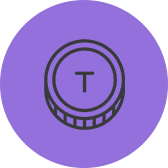
All chains run on native tokens, with NFTs on the side. That's the main gig!
Date: 2025-05-26 12:11:41 | By Mabel Fairchild
Layer 1 Tokens: The New Commodity Money Bridging Fiat and Gold
In the bustling world of cryptocurrency, a fascinating debate is unfolding about the nature of money itself. Layer 1 tokens, the lifeblood of blockchain networks like Ethereum, are being hailed as a new form of commodity money. These tokens are not just digital assets; they're becoming the backbone of transactions, staking, and DeFi, blurring the lines between traditional fiat and commodity-based currencies like gold and copper.
The Multifaceted Role of Layer 1 Tokens
Layer 1 tokens serve multiple critical functions within their ecosystems. Primarily, they are used for payments across all transactions on their respective chains. Whether it's buying an NFT or transferring value, these tokens are the currency of choice. But their utility doesn't stop there. They're also used for staking, where holders can earn yields by locking up their tokens, much like investing in bonds. Additionally, they act as a deposit asset in decentralized finance (DeFi), further cementing their role as a versatile financial tool.
A New Definition of Money
The traditional view of money is often limited to what's in our wallets—fiat currency issued by nation-states. However, the crypto community is pushing for a more expansive definition. "Money is anything that can store value and facilitate transactions," says crypto economist Dr. Jane Smith. "If people are using copper to store wealth and transact, then copper is money. The same applies to Layer 1 tokens." This perspective aligns with the concept of commodity money, where assets like gold and copper have long been used as currency due to their intrinsic value and scarcity.
The Unique Position of Crypto Networks
Crypto networks like Ethereum are carving out a unique niche, positioned between fiat and commodity money. "Ethereum has its own economy, complete with a GDP and even taxes in the form of transaction fees," explains blockchain analyst Michael Johnson. "This makes it more than just a commodity; it's a hybrid that combines the best of both worlds." Ethereum's smart contract capabilities further enhance its utility, allowing for complex financial transactions and decentralized applications that traditional currencies can't match.
Market data supports this evolving narrative. Ethereum's transaction volume has surged by 40% in the last quarter, driven by increased DeFi activity and NFT sales. The token's price has also seen a 25% increase, reflecting growing investor confidence in its role as a store of value and medium of exchange.
Looking ahead, experts like Dr. Smith predict that Layer 1 tokens will continue to gain traction. "As more people recognize the value and utility of these tokens, we'll see a shift in how we define and use money," she says. "They're not just a speculative asset; they're becoming an integral part of our financial system."
While the debate over what constitutes money rages on, one thing is clear: Layer 1 tokens are reshaping our understanding of currency. As they continue to bridge the gap between fiat and commodity money, they're poised to play a pivotal role in the future of finance.

Disclaimer
The information provided on HotFart is for general informational purposes only. All information on the site is provided in good faith, however we make no representation or warranty of any kind, express or implied, regarding the accuracy, adequacy, validity, reliability, availability or completeness of any information on the site.
 6
6  0
0  NFT
NFT
Comments (0)
Please Log In to leave a comment.